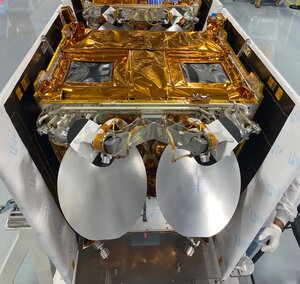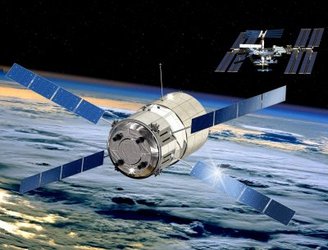Successful design review: ATV gets go-ahead
In early June 2003, the Automated Transfer Vehicle (ATV) programme reached a milestone in successfully passing the Critical Design Review (CDR) during which some 140 international space experts expressed their full confidence in the design of the vehicle after analysing 55 000 pages of technical documentation.
Over the past three and a half months, around 40 engineers from the RSC Energia, 25 from NASA and over 50 from ESA, CNES and Arianespace conducted a full review of the ATV programme through its extensive documentation (presented in electronic format) and did not find anything wrong which would require a change in the design. Seven panels, each consisting of 15 to 20 people, were charged with thoroughly reviewing the various aspects of the programme, such as avionics, systems, software, structure, thermics, as well as quality and operations. Teams from ESA and prime contractor EADS-LV answered their questions and clarification requests.

"The successful completion of the Critical Design Review for the ATV is an extremely important milestone for Europe's contribution to the ISS. The way is now free for the assembly of the first ATV, Jules Verne, and its maiden flight planned for 2007. Together with the Columbus laboratory, ATV is a key European element," said Jörg Feustel-Büechl, ESA's Director of Human Spaceflight.
The purpose of the review was to assess and certify that the ATV design and operations concept meets the requirements for performance, reliability, and safety. The ATV project manager, Robert Lainé, compared the CDR process to sieving through the complete programme to find possible bugs. "The members of these external panels raised some good questions," said Lainé. "Such as asking how the ATV could depart if the ISS was in a critical attitude, or if the ATV should have an extra software backup for re-entry. These remarks are very beneficial, because they help us to think about solutions to possible problems before flying".
In 2000, the Preliminary Design Review (PDR) had to be extended by six months to rethink the overall concept of navigation and guidance, rewrite some specifications and make a few hardware changes. For example, another set of optical sensors (Videometre) was added for rendezvous and docking, and a set of Variable Conductance Heat Pipes (VCHP) was added to cope with large changes in power dissipation in the avionics bay of the spacecraft during orbit.

The successful conclusion of the review is important for the ATV programme since 90% of the flight hardware is already built and the final assembly process started. Any design change would have significantly impacted the scheduled launch of Jules Verne set for 2007.
"The programme is ready to proceed to the next step, yet there is significant work to be done to complete ATV. But we didn't see any design issues that would be a cause to stop or pause. The ATV is on a tight schedule with many challenges ahead. It's scheduled to fly in 2007, but the team is well prepared and the design is ready to go into final build", said Bill Gerstenmaier, the International Space Station Programme Manager at NASA who came to ESA's European Space and Technology Centre (ESTEC) in Noordwijk, The Netherlands, June 4 to attend the final CDR board meeting.
"The success of CDR was a joint effort of European industry and the ESA management team with important involvement of our Russian partners Rosaviakosmos and RSC Energia and full support from the NASA programme team. All contributors should be congratulated for their commitment and encouraged to complete the development of this highly complex spacecraft," said Feustel-Büechl.















 Germany
Germany
 Austria
Austria
 Belgium
Belgium
 Denmark
Denmark
 Spain
Spain
 Estonia
Estonia
 Finland
Finland
 France
France
 Greece
Greece
 Hungary
Hungary
 Ireland
Ireland
 Italy
Italy
 Luxembourg
Luxembourg
 Norway
Norway
 The Netherlands
The Netherlands
 Poland
Poland
 Portugal
Portugal
 Czechia
Czechia
 Romania
Romania
 United Kingdom
United Kingdom
 Slovenia
Slovenia
 Sweden
Sweden
 Switzerland
Switzerland































